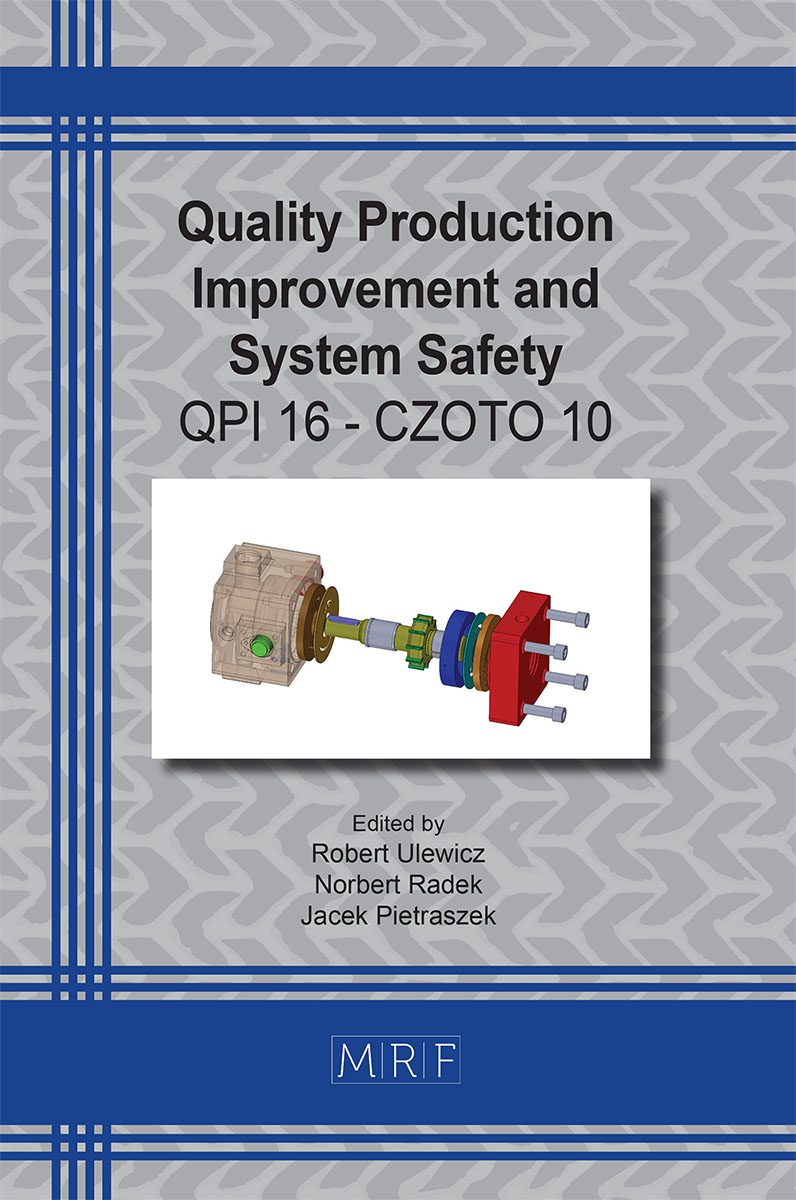Static Mechanical Force Amplifier on the Example of a Fastener with an Electromagnetic Bolt
JASIŃSKI Wiesław, KRYSIAK Piotr, PICHLAK Cezary
download PDFAbstract. Modern mechanical constructions consist of purchased elements and workshop-made elements. Undoubtedly, purchased components – made in specialized factories – have a definite advantage in quality and durability. Unfortunately, sometimes the operating parameters of a component for a given application are insufficient. Then it remains to design and manufacture a given element in the workshop – losing quality and costs. This paper presents a different approach. Application requirements can be customized just include an additional (simple) element, e.g. a force amplifier, and a purchased component can be used.
Keywords
Strength Amplifier, Fastener, Bolt, Construction Optimization
Published online 9/1/2023, 6 pages
Copyright © 2023 by the author(s)
Published under license by Materials Research Forum LLC., Millersville PA, USA
Citation: JASIŃSKI Wiesław, KRYSIAK Piotr, PICHLAK Cezary, Static Mechanical Force Amplifier on the Example of a Fastener with an Electromagnetic Bolt, Materials Research Proceedings, Vol. 34, pp 246-251, 2023
DOI: https://doi.org/10.21741/9781644902691-29
The article was published as article 29 of the book Quality Production Improvement and System Safety
![]() Content from this work may be used under the terms of the Creative Commons Attribution 3.0 license. Any further distribution of this work must maintain attribution to the author(s) and the title of the work, journal citation and DOI.
Content from this work may be used under the terms of the Creative Commons Attribution 3.0 license. Any further distribution of this work must maintain attribution to the author(s) and the title of the work, journal citation and DOI.
References
[1] A. Arian et al. Kinematic and dynamic analysis of the Gantry-Tau, a 3-DoF translational parallel manipulator. Appl. Math. Model. 51 (2017) 217-231. https://doi.org/10.1016/j.apm.2017.06.012
[2] J. Frączek, M. Wojtyra. Kinematyka układów wieloczłonowych – metody obliczeniowe. WNT, Warszawa, 2008.
[3] M. Gawrysiak. Mechatronika i projektowanie mechatroniczne. Wyd. Politechniki Białostockiej, Białystok, 1997.
[4] A. Gronowicz. Podstawy analizy układów kinematycznych. Oficyna Wydawnicza Politechniki Wrocławskiej, Wrocław, 2003.
[5] P. Hejma et al. Analytic Analysis of a Cam Mechanism. Procedia Eng. 177 (2017) 3 10. https://doi.org/10.1016/j.proeng.2017.02.175
[6] S. Miller. Teoria maszyn i mechanizmów – analiza układów kinematycznych. Oficyna Wydawnicza Politechniki Wrocławskiej, Wrocław, 1996.
[7] J. Ormezowski. Analiza dynamiczna mechanizmu hamującego. Archiwum Motoryzacji 1 (2010) 27-34.
[8] A. Sapietova et al. Analysis and Implementation of Input Load Effects on an Air Compressor Piston in MSC.ADAMS. Procedia Eng. 177 (2017) 554-561. https://doi.org/10.1016/j.proeng.2017.02.260
[9] P. Sperzyński, J. Szrek, A. Gronowicz. Synthesis of a mechanism for generating straight line indexing trajectory. Acta Mechanica et Automatica 4 (2010) 124-129.
[10] J. Vavro Jr. et al. Kinematic and dynamic analysis of planar mechanisms by means of the SolidWorks software. Procedia Eng. 177 (2017) 476-481. https://doi.org/10.1016/j.proeng.2017.02.248
[11] J.M. Djoković et al. Selection of the Optimal Window Type and Orientation for the Two Cities in Serbia and One in Slovakia, Energies 15 (2022) art.323. https://doi.org/10.3390/en15010323
[12] J. Korzekwa et al. Tribological behaviour of Al2O3/inorganic fullerene-like WS2 composite layer sliding against plastic, Int. J. Surf. Sci. Eng. 10 (2016) 570-584. https://doi.org/10.1504/IJSURFSE.2016.081035
[13] N. Radek et al. Microstructure and tribological properties of DLC coatings, Mater. Res. Proc. 17 (2020) 171-176. https://doi.org/10.21741/9781644901038-26
[14] N. Radek et al. Influence of laser texturing on tribological properties of DLC coatings, Prod. Eng. Arch. 27 (2021) 119-123. https://doi.org/10.30657/pea.2021.27.15
[15] B. Jasiewicz et al. Inter-observer and intra-observer reliability in the radiographic measurements of paediatric forefoot alignment, Foot Ankle Surg. 27 (2021) 371-376. https://doi.org/10.1016/j.fas.2020.04.015
[16] J. Pietraszek, A. Szczotok, N. Radek. The fixed-effects analysis of the relation between SDAS and carbides for the airfoil blade traces. Arch. Metall. Mater. 62 (2017) 235-239. https://doi.org/10.1515/amm-2017-0035
[17] J. Pietraszek et al. Factorial approach to assessment of GPU computational efficiency in surrogate models, Adv. Mater. Res. 874 (2014) 157-162. https://doi.org/10.4028/www.scientific.net/AMR.874.157
[18] J. Pietraszek et al. The parametric RSM model with higher order terms for the meat tumbler machine process, Solid State Phenom. 235 (2015) 37-44. https://doi.org/10.4028/www.scientific.net/SSP.235.37
[19] J. Pietraszek et al. Challenges for the DOE methodology related to the introduction of Industry 4.0. Prod. Eng. Arch. 26 (2020) 190-194. https://doi.org/10.30657/pea.2020.26.33
[20] J. Pietraszek. Fuzzy regression compared to classical experimental design in the case of flywheel assembly, LNAI 7267 LNAI (2012) 310-317. https://doi.org/10.1007/978-3-642-29347-4_36
[21] J. Pietraszek. The modified sequential-binary approach for fuzzy operations on correlated assessments, LNAI 7894 (2013) 353-364. https://doi.org/10.1007/978-3-642-38658-9_32
[22] J. Pietraszek et al. The fuzzy approach to assessment of ANOVA results, LNAI 9875 (2016) 260-268. https://doi.org/10.1007/978-3-319-45243-2_24
[23] R. Dwornicka, J. Pietraszek. The outline of the expert system for the design of experiment, Prod. Eng. Arch. 20 (2018) 43-48. https://doi.org/10.30657/pea.2018.20.09












